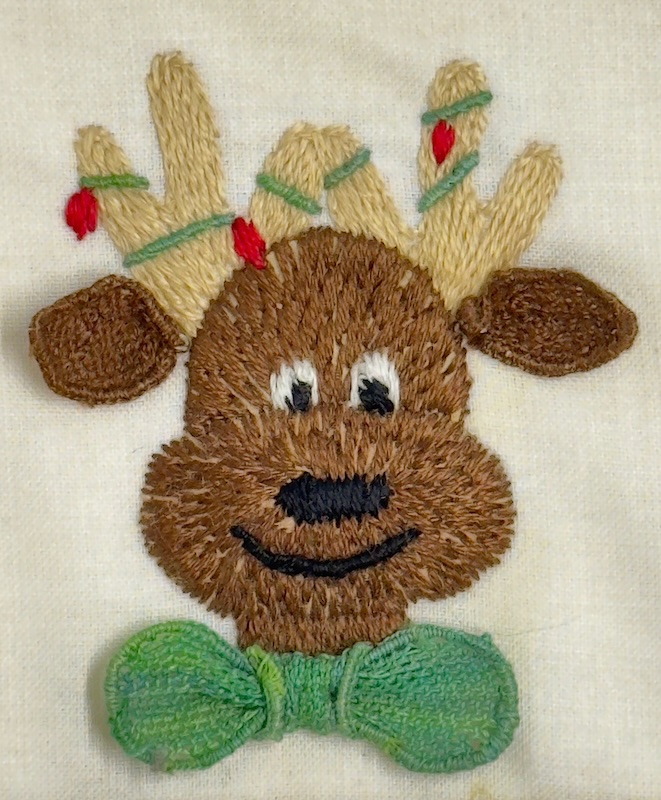- Home
- Stumpwork
Stumpwork Embroidery - A Beginners Guide
Picture a textile that comes alive in your hands, telling stories and evoking emotions with every stitch. That's stumpwork embroidery, an art form with a rich history dating back to 17th century England. It's still relevant today, offering many possibilities for modern-day creativity and personalization.
Building on Tradition
Unlike traditional flat embroidery, stumpwork incorporates raised elements, adding layers of depth and tactile interest to your creation. Also known as raised embroidery, it shows the ingenuity and skill of needleworkers across the ages. Every stitch demonstrates the artist's patience, creativity, and attention to detail.
A Brief History of Stumpwork Embroidery
Initially reserved for sacred items and religious attire, stumpwork has become a beloved art form.
The National Trust at Sudbury Hall in Derbyshire, England, displays a stunning stumpwork box embroidered by Hannah Trapham in 1671. This treasure features animals, flowers, fruit, and elements from the biblical story of Jacob's Ladder.
In the past, teachers instructed children in stumpwork embroidery to develop fine motor skills and creativity. Many museum pieces, like those in the V&A in London, bear the child's age as evidence of their work. Learning this art form taught valuable skills that served young learners well in their personal and professional lives.
Artisans often created stunning decorative pieces for homes and churches, making stumpwork embroidery a highly sought-after skill.
Today, it continues to interest enthusiasts, offering a way to bring textiles to life. Are you ready to try?
Simple Stumpwork Embroidery Techniques
In stumpwork, we'll be using a variety of techniques, each one adding its own special something to the design.
But before you start, make sure you have a solid grounding in basic embroidery stitches.
You will also need some basic equipment:
- an embroidery hoop,
- fabrics
- felt
- needles
- threads
- and wire for shaping three-dimensional elements
Techniques to Get You Started
1. Padding: Layer threads or felt underneath your stitches to create a raised effect. Mould the padding to form various shapes.
2. Raised Stitches: Take your embroidery to new heights with raised stitches creating a three-dimensional effect.
3. Slips: Embroider on a separate piece of fabric and then applique to your project. A little padding can be slipped inside to raise the slip.
4. Wire-Edged Shapes: Create embroidered shapes with wire edges that can stand alone or be used to craft intricate details like wings, leaves, or clothes.
The magic happens when...
...you combine these stumpwork techniques with traditional embroidery methods.
The result?
Truly unique and breathtaking pieces of needlework that show off your creativity and skill!
1a. Padding With Thread
To make a soft foundation simply sew several layers of stitches, going back and forth, to create a soft, cushion.
Take a look at the photo below! I've used cream soft cotton from DMC to demonstrate this method. You'll notice that half of the design has three extra layers of stitches in the middle, adding extra thickness.
Next, I used a beautiful green hand-dyed thread to work a satin stitch over the padded area. This gives the design a gorgeous, smooth finish.
By not placing the padding in the centre, I avoided creating a dome-like shape. Instead, I aimed to mimic the gentle slope of a hill descending towards a river. which hopefully you can see in the second photo.
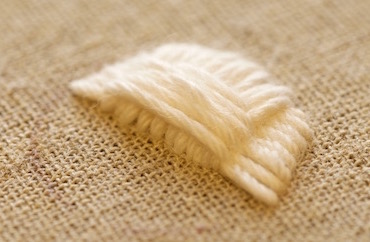 Fig 2 - Padding worked in DMC Soft Cotton
Fig 2 - Padding worked in DMC Soft Cotton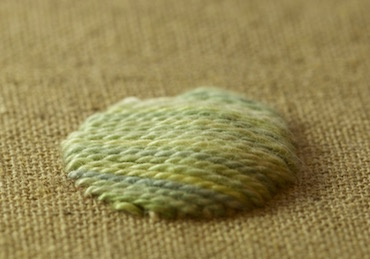 Fig 3 - Satin stitch over the padding
Fig 3 - Satin stitch over the padding1b. Padding With Felt
Now let's explore the magic of using felt beneath your stitches!
For this method cut out three pieces of matching coloured felt in the shape required, making each piece smaller than the previous one. This will avoid the felt showing through in any areas that you accidentally don't fully cover with stitches.
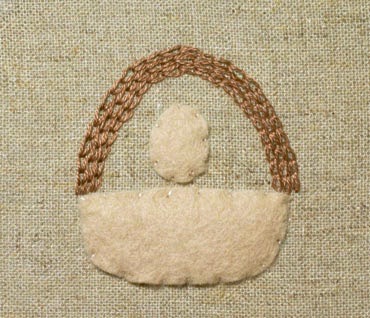 Fig 4 - Felt padding for basket and head
Fig 4 - Felt padding for basket and head
Starting with the smallest shape, take small stitches through the edge and stitch it in place. Cover with the medium sized shape, and attach, then do the same with the largest.
Use small stitches with matching embroidery floss, but don't worry too much, as you will embroider over the felt so these first stitches are unlikely to show.
In the photos above I padded the basket in this way. You can stitch this bunny picture yourself with my free stumpwork tutorial.
2. Raised Stitches
Did you know that the names of embroidery stitches often hold secrets about their texture, appearance, or common usage?
Take a closer look at stitch names like Raised Fishbone, Raised Buttonhole Flowers, or Velvet Stitch. Can you guess what makes them special? Yes, they all stand away from the fabric surface.
These names are like little hints, helping you understand the stitch's unique properties and potential applications in your projects.
Raised Stem Band
Stem stitches by themselves are flat, but by adding stitches beneath them you can create a dimensional line of any width.
Let's look at how to do this.
Pretend you're preparing a garden bed for your embroidery flowers to bloom.
Start by creating a solid foundation with straight stitches across the width of your design shape. Make sure they're neat, parallel, and evenly spaced – just like the rows in a well-tended garden. This will provide a secure base for your stem stitches to grow from.
Rotate your work 90 degrees.
This crucial step will help you create a grid that will support your stem stitches, much like a trellis provides structure for climbing vines.
Now start working rows of stem stitches over your grid, gently sliding your needle underneath each of the foundation stitches. DON'T pierce the fabric, but if you want to ensure the stem stitches stay in place and don't move around you can occasionally catch the foundation stitch to secure your stem stitches. Only do this when necessary.
If you're aiming for a more three-dimensional effect or additional height in your stitching, consider using padding threads. Place these threads under the horizontal foundation stitches before commencing with the stem stitch. This padding will provide extra lift and volume to your embroidery work.
For a more comprehensive understanding and additional techniques on how to perfect the stem stitch, explore my full stem stitch tutorial.
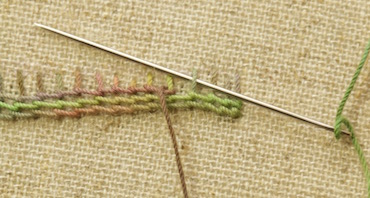 Fig 6 - working raised stem band
Fig 6 - working raised stem band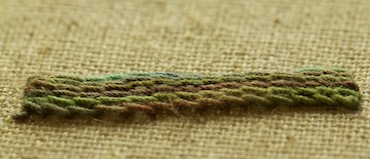 Fig 7 - Raised stem band complete
Fig 7 - Raised stem band completeDetached Stitches
Detached stitches are versatile and can create a lovely texture that really makes your embroidery stand out. One of these is the picot.
I have a step-by-step guide to crafting the needlewoven picot which is used in my stumpwork bunny tutorial mentioned above.
3. Attaching Fabric Slips
You can work part of your embroidery on a slip—a separate piece of fabric or canvas that provides a foundation for your work.
Once you've completed your design, trim around the embroidered shape, allowing a small margin of fabric to remain for handling.
Carefully fold these raw edges to the underside of the shape to ensure a neat appearance when you attach your embroidery onto the main fabric.
For an added touch of volume, consider slipping a little soft cotton thread beneath the slip before securing it in place. This creates a lovely, slightly three-dimensional effect that makes your embroidery stand out even more.
French knots are an excellent choice for this project, as they naturally create a subtle raised texture.
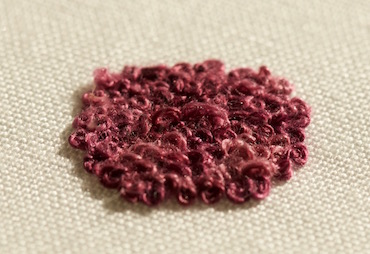 Fig 8 - Stitched french knots slip
Fig 8 - Stitched french knots slip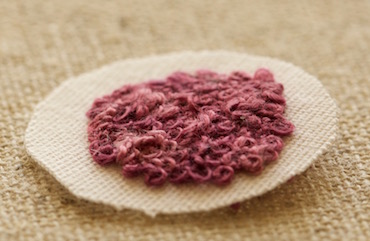 Fig 9 - Slip cut out
Fig 9 - Slip cut out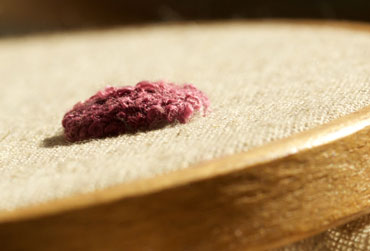 Fig 10 - Slip attached to project
Fig 10 - Slip attached to project4. Wired Shapes
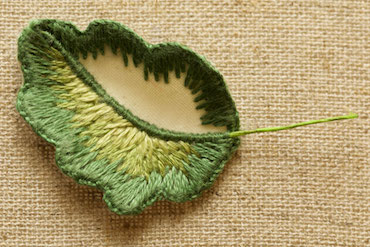 Fig 11 - Wired leaf in progress
Fig 11 - Wired leaf in progressSometimes you will want an element in the design to stand proud of the surface not just to be padded.
Work your element on a separate piece of fabric, as for a normal slip. But this time lay a wire along the edge and hold it in place with couching stitches before filling your shape with stitches.
Then work your embroidery right over the wired edge, I used long and short stitch in the example leaf above.
you've completed the embroidery over the wired edge, it's time to trim away the excess fabric. Grab your sharp scissors and carefully cut close to the wired edge. Be gentle, as you don't want to snip those precious stitches or the wire itself. This will give you a neat edge, perfect for adding depth to your design.
You may also like to lay wire down the centre of your leaf as a vein for added detail.
Then insert the wire ends through your background fabric and secure in place on the back of your project.
A Key Tip: Work from Far to Near
Always start with the elements that appear furthest away in your design and work your way forward.
This ensures that the most prominent features are added last, creating a convincing 3D appearance.
The Beauty of Stumpwork
Remember, the magic of stumpwork lies in its texture and dimension. Take your time with each step, and don't be afraid to experiment with different techniques.
This is where the real fun begins! Enjoy the process, and watch your creative vision come to life.
Happy stitching!
Avoid cutting any wire with your expensive embroidery scissors!
A pair of wire cutters are better for this.
Frequently Asked Questions (FAQs)
Is stumpwork the same as 3D embroidery?
Is stumpwork the same as 3D embroidery?
They’re closely related — stumpwork is a historical style of three-dimensional embroidery that uses specific techniques such as padding, slips and wired edges.
What kind of wire should I use for wired shapes?
What kind of wire should I use for wired shapes?
Use a soft, thin wire suited to jewellery or floristry (around 26–30 gauge) — it should bend easily and hold shape without being so stiff that it’s hard to stitch over.
Can I use regular felt for padding?
Can I use regular felt for padding?
Yes — craft or wool felt cut into graduated layers works well; make each layer slightly smaller than the one beneath so the felt doesn’t show through the stitches.
Why is my padding showing through the stitches?
Why is my padding showing through the stitches?
Padding often shows because the underlying layers are too large or the overlay stitches are too sparse; make each padding layer slightly smaller and work closer, denser cover stitches.
How should I clean and finish stumpwork pieces?
How should I clean and finish stumpwork pieces?
Avoid machine washing; gently spot-clean or take delicate pieces to a specialist cleaner, and store or frame works flat with acid-free backing to protect the raised elements.
Stay connected between projects
If you’d like occasional updates from my embroidery room, including new patterns, gentle tips, and little things I think you might enjoy, you’re warmly invited to join the Stitchin’ Times newsletter.
No pressure. Just a friendly note now and then to keep you inspired.
